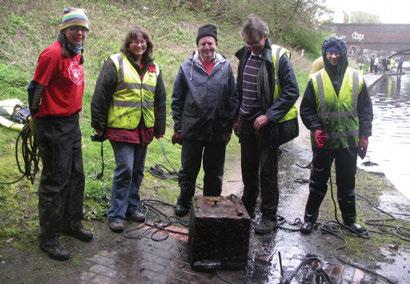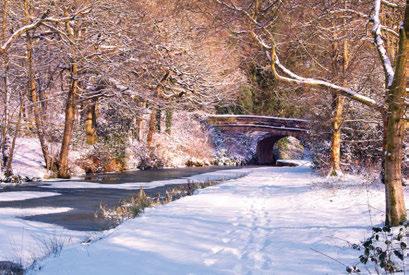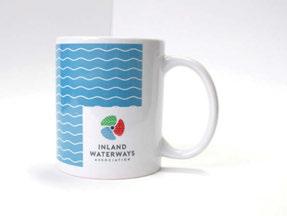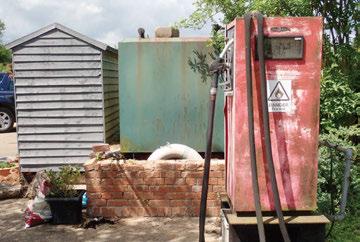
12 minute read
on the campaign trail


Alison on her dinghy.
Can you tell us briefly what your job entails?
There are four main strands: coordinating IWA’s parliamentary campaigning, leading on IWA’s national navigation campaigns, I’m part of IWA’s press o ce and I also do the secretariat for IWA’s Navigation Commi ee. I was fi rst employed by the Association seven years ago with the sole remit (as branch campaigns o cer) to get IWA branch work parties up and running. Since then my role has gradually evolved to become what it is now.
I’m away om home once or twice a month at meetings either in London (at Westminster), or with navigation authorities. I also try to spend a day a month at IWA head o ce in Chesham, which enables me to catch up with colleagues and have meetings about specifi c projects or campaigns we’re working on. The rest of the time I’m working om home in Sta ordshire overlooking the Caldon Canal.

Alison (l) talks to MPs at IWA’s annual parliamentary dinner. Aboard her historic tug Sandbach.
Waterways talks political wrangling, MBEs and WRGie marriage with IWA’s policy & campaigns o cer Alison Smedley
IWA has a long history of successful political campaigning. Do you still think it's one of the organisation's overriding strengths?
Defi nitely. In particular our campaigning for the future funding of the publicly funded waterways. Canal & River Trust enjoys the good contract with Government that it has directly as a result of IWA’s work in the years leading up to the chari being launched, and we continue to campaign for be er funding for the Environment Agency navigations too.
Have ongoing Brexit negotiations impeded these efforts recently?
They certainly haven’t helped, especially all the good work concerning the potential transfer of EA navigations to CRT. And there’s been a lot of change in politics as a result of Brexit, not least a new waterways minister [the previous incumbent, Therese Co ey, was moved to secretary of state for work and pensions following Amber Rudd’s resignation in September]. Hopefully, however, the new one will be a breath of esh air as we certainly haven’t had much interaction with the waterways minister in recent years, which has been ustrating.


above: Alison being
interviewed for local TV news on the Old Bedford River Campaign Cruise in August 2018.
Left: Leading a Himalayan balsam work party in 2013.
right: Alison (second
from left) joins volunteers on a BCN clean-up in 2014.

Would you say IWA's policies and campaigns are generally more reactive or proactive?
In the past they’ve tended to be very reactive, but we’re trying to change that. One challenge is the sheer breadth of issues we campaign upon, everything from very small things to do with lock ladders or paddle pawl stops, for example, all the way up to the big issues like waterways funding – and everything else in-between. A recent example and success story can be seen at Ely, on the River Ouse, where EA was looking to sell off some river frontage – despite it actually bringing in a regular income for EA, and providing valuable visitor moorings for people using the river. We wrote letters to the waterways minister and encouraged our members to do the same to the MPs and the local authorities who would be impacted by it. One of the businesses that was going to be affected was a hire-boat company – the last remaining hire base on the Ouse. If that disappeared, a number of businesses along the entire River Ouse would suffer. Ultimately we were successful and the local authority ended up taking it on. And so those moorings continue to be in use.
How do you pick your battles?
Where people write to IWA we always try to offer advice, responding to enquiries from people as diverse as riparian landowners and cyclists. A lot of this correspondence gets directed to me, and invariably I can give advice based on the information we already have available on the website (policies, briefing notes etc). They can often use this on their own to campaign locally, or I’ll notify the relevant IWA Branch to support them.
If it’s something significant I’ll take it to the next meeting of Navigation Committee, who will then give a view on whether it has national implications and whether we should get involved more formally.
What are the best parts of the job?
One of the most exciting parts is visiting the Houses of Parliament. I tend to go for the meetings of the All-Party Parliamentary Waterways Group, which IWA supports by providing the secretariat, and we also organise at least one parliamentary event a year – either a reception or a dinner – where we invite targeted MPs who we know are particularly supportive of the waterways.
After the last two general elections we’ve held a more informal drop-in reception, to which we’ve invited all the new MPs. This has followed on from IWA’s introduction, in 2015, of a Waterways Manifesto, which has proved a great way of engaging MPs.
I’ve since created a spreadsheet of all the constituencies that have waterways (whether navigable or restoration projects) in them, and we’re in the process of making this resource available on the website. Of the 650 constituencies in England, Scotland and Wales, there are 408 with either navigable waterways or active restoration projects. It takes quite a lot of updating – every time an MP changes political party, for example, which has happened more than usual in the past few months! I’m tempted to just take that column out!
What areas do you think IWA's campaigning will focus on over the coming years?
Waterways funding is always going to be important, as is affordable boating (whether that be licensing costs or simply the ease of getting small boats out on our canals and rivers). We’ve also recently set up a sub-group at Navigation Committee to look at alternative forms of propulsion, not just in the light of the red diesel tax situation, but also looking at greener boating. Although diesel engines on inland waterways comprise a tiny, tiny proportion of what is impacting the environment, by the time everyone else has cleaned up their act (cars have gone electric etc), we’ll suddenly be a relatively bigger part of the problem. We need to be doing research, getting advice, and then lobbying navigation authorities to provide whatever’s required. In the short-term it might just be many more electric hook-up points whereby boaters can plug in and avoid having to run their engines to charge batteries, or to use electric heaters instead of smoky solid-fuel stoves.
How did you become interested in the waterways?
My parents were IWA members before I was born and used to hire regularly. When I was seven they bought a Humber keel, which we lived in on the Thames until I was 11. That left me with a real love of the waterways. When I left home, aged 19, it was to move onto a boat of my own. My dad immediately

Bellanoch Swing Bridge on the Crinan Canal – Alison’s favourite Scottish waterway.
bought me IWA membership, although I didn’t get actively involved for some time. The following year I quit my job and spent the year travelling around the network. I’d also started boating to IWA national festivals and I’d often enviously watch volunteers in their red T-shirts relaxing in the beer tent, without quite plucking up the courage to chat to them.
In November 1992, while living aboard in Uxbridge, I went along to my first IWA meeting and it changed my life entirely. The speaker that night was Tim Lewis, talking about London WRG, and I got recruited to the fledgling IWA Middlesex section committee, attending its inaugural meeting a few of weeks later. I also went along to my first London WRG dig too. In fact, in 1993 I went on almost every London WRG dig I could, and that’s how I met my husband, Rupert.
A few years after marrying we moved to Staffordshire. We wanted somewhere near the water for our boats and, to cut a long story short, we ended up on the Caldon Canal with moorings at the bottom of the garden. We have frontage to the Leek Arm and the main line, but they’re not adjacent to each other, it’s not on a junction. In fact, it actually takes an hour to boat from one end of the garden to the other, which always gives everyone completely the wrong idea about the size of our property! Another canal curiosity in the garden is the remains of a staircase flight of locks from one of the earlier layouts of the canal.
Do you still find time to boat?
Absolutely. Last year we did a mammoth three-week trip on Sandbach, a 35ft historic tug. There were three of us – me, Rupert and our 14-year-old son, Peter – plus Peter’s kayak, my dinghy and the cat. Despite the cramped quarters we had a fabulous time! We cruised all the way from Hemel Hempstead, up the Grand Union and down the Nene, across the Middle Level and up to the IWA Festival of Water at St Neots, and then onto Bedford, where Sandbach has taken up a mooring. It was great having the kayak and dinghy and exploring the backwaters, and also using them to take part in IWA’s campaign cruise on the Old Bedford River, which I’d helped organise. Although I’m very familiar with CRT waters, I’m much less so with EA ones other than the Thames. When, in 2015, IWA’s campaign for better funding for EA waterways started kicking off, I realised I didn’t know enough about them, so that was one of the reasons we went boating there that year too. My role as IWA campaigns officer is now influencing where we cruise!
Are there any waterways remaining on your boating bucket list?
There are still some places I haven’t done, and some Rupert hasn’t done. Between us we want to tick them off – places like the Yorkshire Ouse up to York and Ripon, for example.
What’s been your biggest waterways achievement to date?
One of the most satisfying things I’ve done is boating through locks Rupert and I both worked on as WRG volunteers on the Droitwich Canals in the late ’90s. To finally take a boat through there was a lovely feeling. It’s a similar story with the restored lock at Froghall on the Caldon Canal. I led the volunteer input there and seeing that lock reopened is still probably one of my biggest waterways achievements.
Not your MBE?! How did that come about?
I received it nearly ten years ago, before I was an IWA employee. I suppose it was in recognition of 18 years of volunteering with IWA and other organisations, such as local canal societies and the Historic Narrow Boat Club. At one point, before Peter was born, I was on about six different committees, taking the minutes for all of them, as well as being an IWA trustee. Throughout this I worked in boring, mundane admin jobs because I spent all my spare time messing about on the waterways. That was my real priority – not pursuing a traditional ‘career’. Funnily enough though, the secretarial skills I learned enabled me to excel on the admin side of my volunteering. I still pride myself on my minute-taking!
As far as I can gather, the MBE was awarded because I was always behind the scenes. I wasn’t the chairman or the person standing up taking the credit, but I did all the form-filling, minutes, coordination, planning and other donkey work. I kept doing it even after I had a baby. I only missed one IWA Trustee meeting – and that was four days after giving birth! I still volunteer for IWA with my local Branch, and Rupert and I are both actively involved with the Caldon & Uttoxeter Canals Trust, so I’ve been volunteering on the waterways for 27 years now!
Which waterways will always be closest to your heart?
From my 1990 trip around the country the Caldon Canal stood out as my favourite, which is why many years later when the opportunity came up to buy a house there we seized it. And I’ll always have a soft spot for the entire length of the River Thames.
But I also have a love affair with Scottish waterways and the Crinan Canal is probably my favourite. I’ve never boated it, and that remains one of my dreams.
£3.60

per pack

Christmas CardsPrinted by Judge Sampson of Hastings (01424) 420919
(Printed on high quality card. Supplied in packs of ten per design.)

Message inside: “With Best Wishes for Christmas and the New Year”.

Printed by Judge Sampson of Hastings (01424) 420919 Whitchurch Arm of the Llangollen Canal Original painting by Ann FarrellPrinted by Judge Sampson of Hastings (01424) 420919
Code x126
new design
Chirk Aqueduct on the Llangollen Canal
Original painting by Dave Gardham
Code x127
back by popular demand
Printed by Judge Sampson of Hastings (01424) 420919 Bridge No. 7 on a Wintry Caldon Canal Photographed by Rosalind Kirk
Code x128
Hoar Frost
Original painting by Alan Firth
Code x013
IWA Branded merchandise
back by popular demand


IWA A5 Lined Notebooks (70 pages)
£3.00 each
Printed by Judge Sampson of Hastings (01424) 420919
£7.50 per set
Code IWA303
Kidderminster Church
Original painting by Dave Gardham
Code x112


IWA Mugs
£5.00 each
(ceramic mugs in a gift box) 78mm diameter, 97mm height.

Blue - Code IWA304 Green - Code IWA305 Red - Code IWA306 Why not buy a set?
Code IWA308

£12.00 per set IWA Tea Towel


£4.00
(Cotton) 470mm x 740mm
Code IWA309
Lots more designs available at waterways. org.uk/ shop
Postage is free on specified items, however when they are purchased with nonspecified items, UK postage costs £3.25. Free postage when you spend over £20. Different postage costs apply for Europe and overseas. See website for details.









